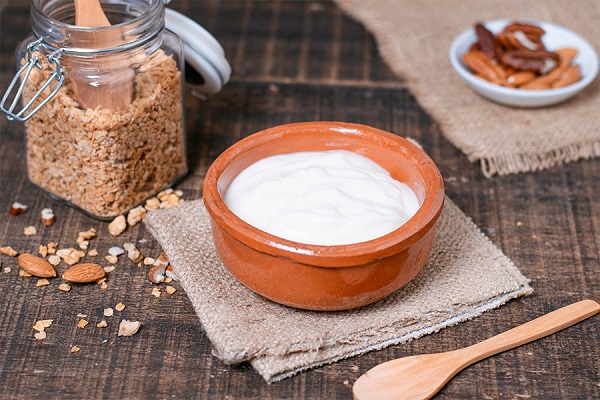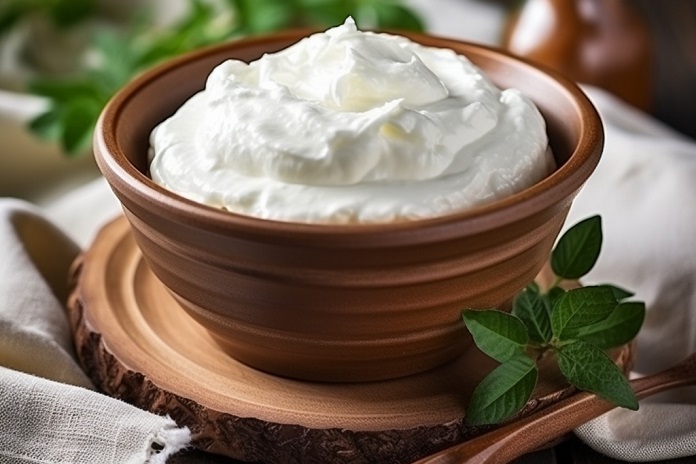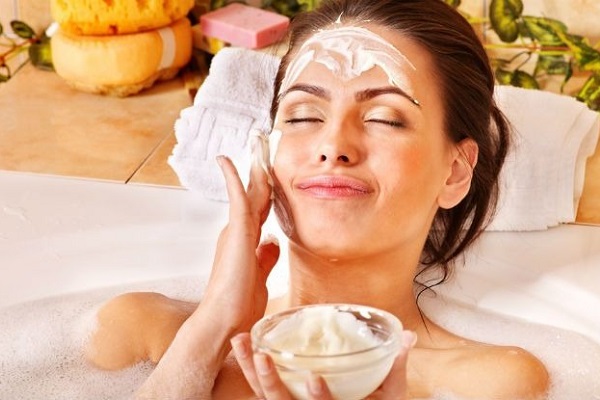1. Hydrates and Moisturizes the Skin
As I have already mentioned, Curd has a high water content and contains lactic acid, which helps in attracting and retaining moisture in the skin. The lactic acid acts as a humectant, that draws moisture from the environment into the skin and prevents water loss.
Benefits:
Prevents Dryness: This keeps the skin soft and hydrated, especially beneficial for those with dry or sensitive skin.
Softens Skin: Regular use helps maintain a supple and smooth texture.
2. Improves Skin Texture
Curd contains lactic acid, an alpha-hydroxy acid (AHA), that gently exfoliates the skin by dissolving dead skin cells and promoting cell turnover. This leads to a smoother and more even skin texture.
Benefits:
Smoother Skin: Removes dead skin cells and unclogs pores, leading to a smoother skin surface.
Reduces Rough Patches: Helps in reducing rough or uneven patches on the skin.
3. Brightens the Skin
The natural enzymes and acids in curd help in fading pigmentation and dark spots. Lactic acid helps to exfoliate the skin and enhance its radiance by removing the top layer of dead skin cells.
Benefits:
Radiant Glow: Provides a natural glow by removing dull and dead skin cells.
Even Skin Tone: Helps in lightening dark spots and pigmentation for a more uniform complexion.
4. Reduces Acne and Pimples
Curd contains probiotics and lactic acid, which have antibacterial and anti-inflammatory properties. These properties help to balance the skin’s microbiome, reduce inflammation, and combat acne-causing bacteria.
Benefits:
Soothes Inflammation: Reduces redness and swelling associated with acne.
Prevents Breakouts: Helps in controlling excess oil and maintaining a healthy balance of skin bacteria.
5. Soothes Sunburn
Curd has a cooling effect and is rich in nutrients that help to repair and smooth sun-damaged skin. Its anti-inflammatory properties help reduce redness and inflammation caused by sun exposure.
Benefits:
Relieves Burning Sensation: Provides immediate relief from the burning sensation of sunburn.
Promotes Healing: Helps in the recovery and repair of sun-damaged skin.
6. Tightens and Firms the Skin
The proteins in curd, along with its lactic acid content, contribute to enhancing skin elasticity and firmness. However, this helps in tightening the skin and reducing the appearance of fine lines.
Benefits:
Reduces Sagging: Helps in improving skin firmness and elasticity.
Minimizes Fine Lines: This can reduce the appearance of fine lines and wrinkles over time.
7. Reduces Dark Circles
Curd is hydrating and soothing, that helps to nourish the delicate skin under the eyes. Its moisturizing properties can reduce the appearance of dark circles by improving blood flow and hydration.
Benefits:
Brightens Under-Eye Area: Reduces the appearance of dark circles and puffiness.
Hydrates Sensitive Skin: Provides gentle hydration to the delicate under-eye area
8. Balances Skin’s Oil Production
Curd helps regulate oil production by maintaining the skin’s natural moisture balance. Also, it hydrates the skin without making it greasy, which is ideal for oily and combination skin types.
Benefits:
Controls Excess Oil: Helps in managing oil production and reducing shine.
Maintains Balance: Keeps the skin hydrated without overloading it with oil.
9. Reduces Pigmentation
Curd’s mild bleaching properties, combined with other ingredients like lemon or tomato juice, help in lightening pigmentation and dark spots. Lactic acid and other enzymes in curd can help in reducing hyperpigmentation.
Benefits:
Lightens Dark Spots: Helps in fading hyperpigmentation and uneven skin tone.
Improves Complexion: Enhances overall skin brightness and clarity.
10. Cleanses the Skin
Curd acts as a mild cleanser due to its natural lactic acid content. It helps in removing impurities and excess oils while maintaining the skin’s natural moisture balance.
Benefits:
Cleanses Gently: Cleanses the skin without stripping it of its natural oils.
Refreshes Skin: Leaves the skin feeling clean and refreshed.

Easy To Use Curd Face Packs
Here are the simple homemade face packs that you can apply for a healthy and daily face glow:
Hydrating Curd and Honey Pack:
Ingredients: 2 tablespoons of curd, 1 tablespoon of honey
How to apply: Mix and apply to your face. Leave on for 15-20 minutes and rinse. Honey enhances the moisturizing effects of curd.
Brightening Curd and Lemon Pack:
Ingredients: 2 tablespoons of curd, 1 teaspoon of lemon juice
How to apply: Mix and apply. Leave on for 15-20 minutes and rinse. Lemon juice brightens the skin, while curd provides hydration.
Acne-Fighting Curd and Turmeric Pack:
Ingredients: 2 tablespoons of curd, 1 teaspoon of turmeric powder
How to apply: Mix and apply to affected areas. Leave on for 15 minutes and rinse. Turmeric helps reduce acne inflammation.
Firming Curd and Avocado Pack:
Ingredients: 2 tablespoons of curd, 1 tablespoon of mashed avocado
How to apply: Mix and apply. Leave on for 20 minutes and rinse. Avocado provides additional moisturizing and firming benefits.
Sunburn Relief Curd Pack:
Ingredients: 3 tablespoons of curd
How to apply: Apply directly to sunburned skin. Leave on for 15-20 minutes and rinse. Curd soothes and hydrates sun-damaged skin.
Oil-Control Curd and Fuller’s Earth Pack:
Ingredients: 2 tablespoons of curd, 1 tablespoon of Fuller’s earth
How to apply: Mix and apply. Leave on until dry and rinse. Fuller’s earth absorbs excess oil while curd hydrates.
Dark Circle Soothing Curd Pack:
Ingredients: 1 tablespoon of curd
How to apply: Apply under the eyes. Leave on for 10 minutes and wipe off. Helps reduce dark circles and puffiness.
Pigmentation Lightening Curd and Tomato Pack:
Ingredients: 2 tablespoons of curd, 1 teaspoon of tomato juice, a pinch of turmeric
How to apply: Mix and apply to pigmented areas. Leave on for 20 minutes and rinse. Tomato juice and turmeric aid in lightening dark spots.
Cleansing Curd and Cucumber Pack:
Ingredients: 2 tablespoons of curd, 1 tablespoon of mashed cucumber
How to apply: Mix and apply. Leave on for 10-15 minutes and rinse. Cucumber cools and cleanses, while curd provides a mild cleansing effect.
Exfoliating Curd and Oatmeal Scrub:
Ingredients: 2 tablespoons of curd, 1 tablespoon of finely ground oatmeal
How to apply: Mix and apply in circular motions. Rinse off with lukewarm water. Oatmeal exfoliates, and curd soothes and cleanses.

Who should not use it?
As we already know there are pros and cons to everything similarly in this article i will share who should not use this remedy:
-
Those with Dairy Allergies or Lactose Intolerance
Why you should not use: Curd is a dairy product and can contain lactose. Individuals with a dairy allergy or lactose intolerance might experience allergic reactions or irritation from applying curd to their skin.
Instead of this, you can: If you have a dairy allergy, consider using non-dairy alternatives like almond yogurt or coconut yogurt, which can offer similar benefits without the risk of an allergic reaction.
-
People with Sensitive or Allergy-Prone Skin
Why you should not use: Although curd is generally gentle, some people with extremely sensitive or allergy-prone skin might react negatively. This can be due to the lactic acid or any additives in commercial curd products.
Instead of this, you can: Conduct a patch test before applying curd to your entire face. If you have sensitive skin, opting for hypoallergenic or organic curd, or diluted versions of the face packs, might reduce the risk of irritation.
-
Individuals with Severe Acne or Active Breakouts
Why you should not use: While curd has anti-inflammatory properties that can help with mild acne, those with severe acne or active breakouts might find that dairy products can sometimes exacerbate their condition due to increased oil production or sensitivity.
Instead of this, you can: Consider using acne-specific treatments or products with ingredients like salicylic acid or benzoyl peroxide. Consult with a dermatologist for tailored advice.
-
People with Very Oily Skin
Why you should not use: Curd, while hydrating, might be too rich for those with very oily skin types. It can potentially contribute to excess oil and make the skin feel greasy.
Instead of this, you can: If you have very oily skin, opt for curd face packs that include oil-absorbing ingredients like fuller’s earth or clay. Alternatively, look for oil-free or mattifying face masks.
-
Those Using Prescription Skincare Products
Why you should not use: If you are using prescription skincare treatments (like retinoids or other strong medications), applying curd may interfere with the effectiveness of these treatments or cause unexpected interactions.
Instead of this, you can: Consult with your healthcare provider or dermatologist to ensure that curd or any other natural remedy is compatible with your prescribed skincare regimen.
-
Individuals with Skin Conditions like Eczema or Psoriasis
Why you should not use: Skin conditions like eczema or psoriasis may react unpredictably to dairy products. The application of curd might worsen symptoms or cause flare-ups.
Instead of this, you can: If you have eczema or psoriasis, it’s best to stick to treatments specifically designed for these conditions. Consult with a dermatologist for advice on suitable products.
-
Those with Recent Skin Treatments or Procedures
Why you should not use: If you’ve recently undergone treatments like chemical peels, laser therapy, or other invasive procedures, your skin may be too sensitive for curd or other new ingredients.
Instead of this, you can: Follow your dermatologist’s aftercare instructions carefully and avoid introducing new products until your skin has fully healed.
-
People with Open Wounds or Infections
Why you should not use: Applying curd to open wounds or active infections can lead to irritation or infection, as curd is not a sterile product.

Safety Tips
Here are some of the safety tips I have come up with,
- Patch Test: Always do a patch test before using curd on your face. Apply a small amount to a discreet area and wait 24 hours to check for any allergic reactions or irritation.
- Use Fresh, Organic Curd: Opt for plain, organic curd without additives or preservatives to minimize the risk of irritation and ensure purity.
- Avoid Broken or Irritated Skin: Do not apply curd to open wounds, cuts, or areas with active irritation to prevent discomfort or infection.
- Monitor Skin Reactions: Pay attention to how your skin responds after using curd. If you experience redness, itching, or swelling, discontinue using it immediately.
- Do Not Overuse: Limit the use of curd face packs to 2-3 times a week to avoid overloading your skin and causing potential dryness or imbalance.
- Ensure Proper Hygiene: Use clean utensils and containers to mix and apply curd to avoid contamination.
- Consult a Dermatologist: If you have specific skin conditions, are using prescription treatments, or are unsure about compatibility, seek professional advice before incorporating curd into your skincare routine.
- Avoid Mixing with Strong Actives: Avoid combining curd with strong skincare ingredients like retinoids or high concentrations of vitamin C to prevent potential interactions or irritation.
Conclusion
Curd is a natural skincare powerhouse due to its rich nutritional content and multifaceted benefits. From hydrating and moisturizing to reducing acne and pigmentation, incorporating curd into your skincare routine can address various skin concerns effectively. By using the face packs and remedies outlined above, you can harness the natural benefits of curd to achieve healthier, more radiant skin.
FAQs
How often should I use curd on my face?
Generally, it is recommended to use curd-based face packs 2-3 times a week. However, Overuse can lead to skin irritation or imbalance.
Cn curd help with dark spots and pigmentation?
Yes, curd can help lighten dark spots and pigmentation due to its natural exfoliating properties and lactic acid, which promotes skin renewal and reduces hyperpigmentation over time.
Is it safe to use curd if I have sensitive skin?
If you have sensitive skin, it’s crucial to perform a patch test first. Use plain, organic curd and start with a diluted application to ensure it doesn’t irritate.
Can curd be used on oily skin?
Curd can be used on oily skin, but it’s important to combine it with oil-absorbing ingredients like clay or fuller’s earth to prevent excessive oiliness and maintain balance.
Will curd help with acne?
Curd can help with mild acne due to its anti-inflammatory and probiotic properties, which can soothe inflammation and balance skin flora.
Also, read more about 5 Benefits of Using Aloe Vera (Hair Edition)

